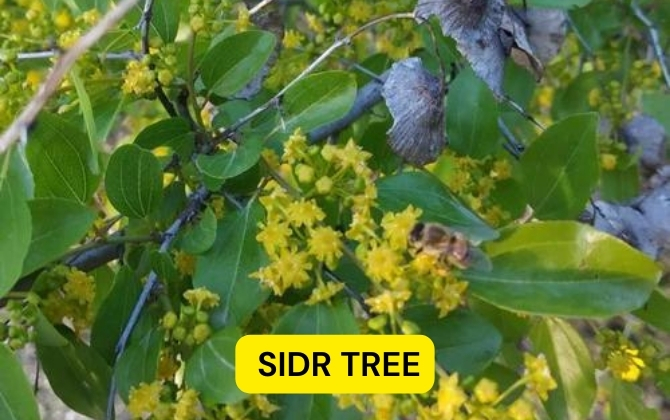The Sidr tree, also known as the Lote tree or Christ’s Thorn Jujube (scientifically named Ziziphus spina-christi), is a natural marvel celebrated for its deep-rooted cultural significance and unique characteristics. This tree thrives in various regions, including the Middle East, North Africa, and Asia, and has held a place of reverence for centuries. Its significance extends beyond its botanical beauty, playing an essential role in both the environment and spiritual traditions.
Botanical Characteristics of Sidr Tree:
Appearance
The Sidr tree is a medium-sized deciduous tree known for its distinct, twisted trunk and branches. Its leaves are shiny, oval-shaped, and have serrated edges, giving it a characteristic appearance that stands out in any landscape.
Flowers
Blooming with small, fragrant yellowish-white flowers, the Sidr tree offers a delightful scent that attracts bees and other pollinators. These flowers are not just pleasing to the senses but are essential for the production of the renowned Sidr honey.
Fruit
The Sidr tree produces small, round fruits known as “Sidr” or “Nabq.” These fruits, which turn reddish-brown when ripe, are edible and cherished for their sweet taste. Historically, they have been consumed for their nutritional benefits, adding another layer of value to this remarkable tree.
Biology and Habitat
Belonging to the Ziziphus genus, the Sidr tree is an evergreen that boasts drought resistance, making it well-suited for arid and semi-arid environments. It features thorny branches and elliptical, glossy green leaves that provide much-needed shade in harsh climates.
The tree’s ability to thrive in dry conditions is partly due to its deep taproots, which reach groundwater and help it survive extended drought periods.
Cultural and Religious Significance
The Sidr tree holds a place of honor in various cultures, particularly within Islamic traditions. It is mentioned in the Quran as one of the blessed trees found in paradise, which elevates its status to a sacred symbol. This religious association has made the Sidr tree a common sight near religious sites, homes, and communal areas.
The tree’s branches and leaves are often used in traditional ceremonies, symbolizing strength, endurance, and resilience. Additionally, the wood of the Sidr tree is prized for its durability, used in crafting a variety of traditional items.
Sidr Honey Production
One of the most celebrated products derived from the Sidr tree is Sidr honey which has various benefits for athletes due to its nutritional properties. Bees collect nectar from the fragrant flowers of the Sidr tree, producing honey with a distinct taste, aroma, and therapeutic properties. Sidr honey is renowned for its purity and is often considered a luxury item due to its scarcity and unique production process. You can incorporate this honey into your daily routine with these Sidr honey DIY beauty treatments or delicious recipes.
The harvesting of Sidr honey is a meticulous and time-sensitive process. Beekeepers carefully extract honey from hives placed near Sidr tree groves during the flowering season, ensuring that the honey captures the essence of the Sidr blossoms. The result is a honey that is not only delicious but is also believed to have various medicinal benefits in traditional medicine.
Ecological Importance
Beyond its cultural and economic value, the Sidr tree plays a vital role in maintaining ecological balance. Its deep roots help prevent soil erosion, especially in arid regions, and the tree provides shelter and habitat for a wide range of fauna. The flowers attract pollinators, enhancing biodiversity, while the fruits offer a food source for both humans and wildlife.
Conservation Efforts
Despite its resilience, the Sidr tree faces threats from habitat loss, overharvesting, and climate change. Recognizing the importance of preserving this tree, various conservation initiatives have been launched. These efforts include planting programs, promoting sustainable harvesting practices, and raising awareness about the ecological and cultural significance of the Sidr tree.
Conclusion
The Sidr tree stands as a symbol of the harmonious relationship between nature, culture, and spirituality. Its presence in various landscapes and traditions is a testament to the deep connection humans have with their environment. As conservation efforts continue to protect and celebrate the Sidr tree, its legacy—both cultural and ecological—will endure for generations to come.
For additional information on top-quality Yemeni Sidr honey, visit Yemeni Sidr Honey in Dubai.









